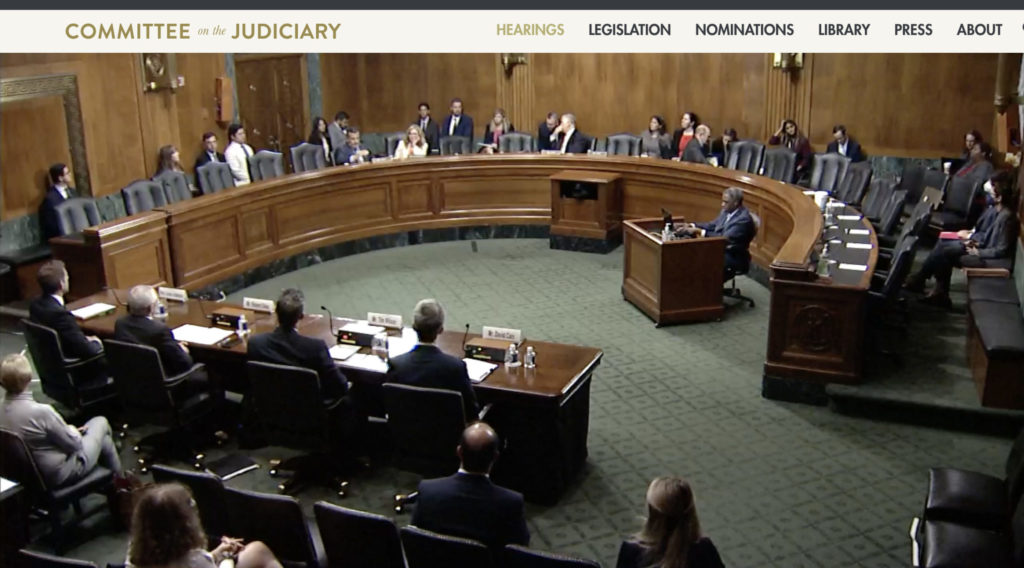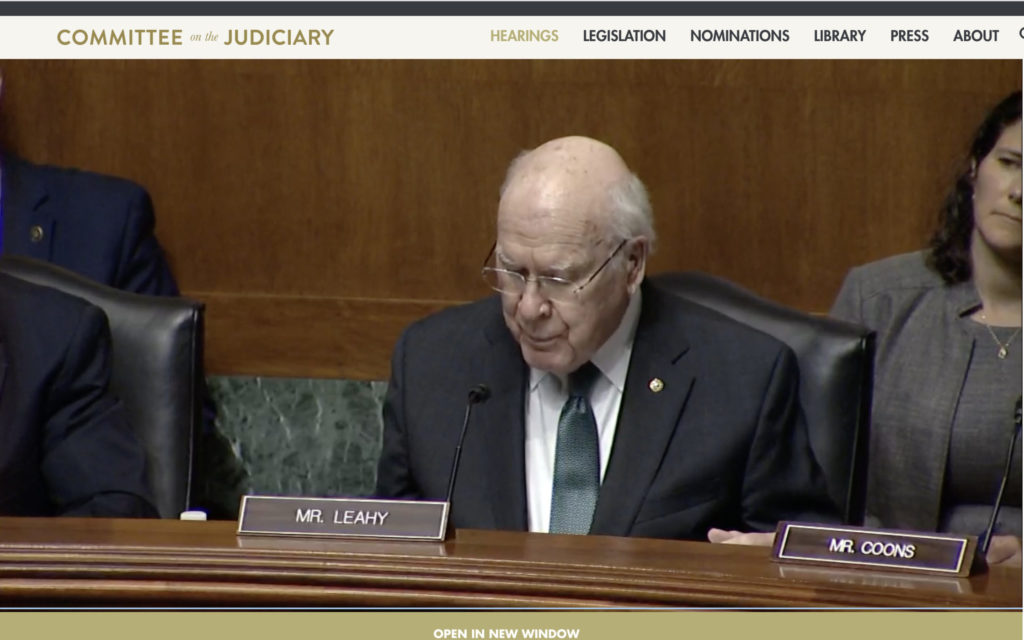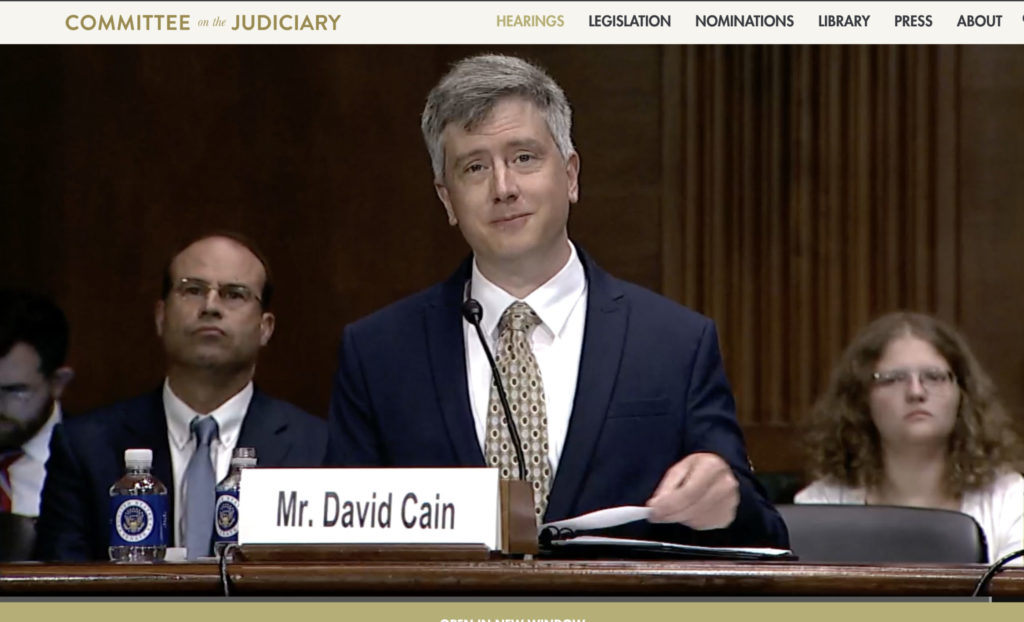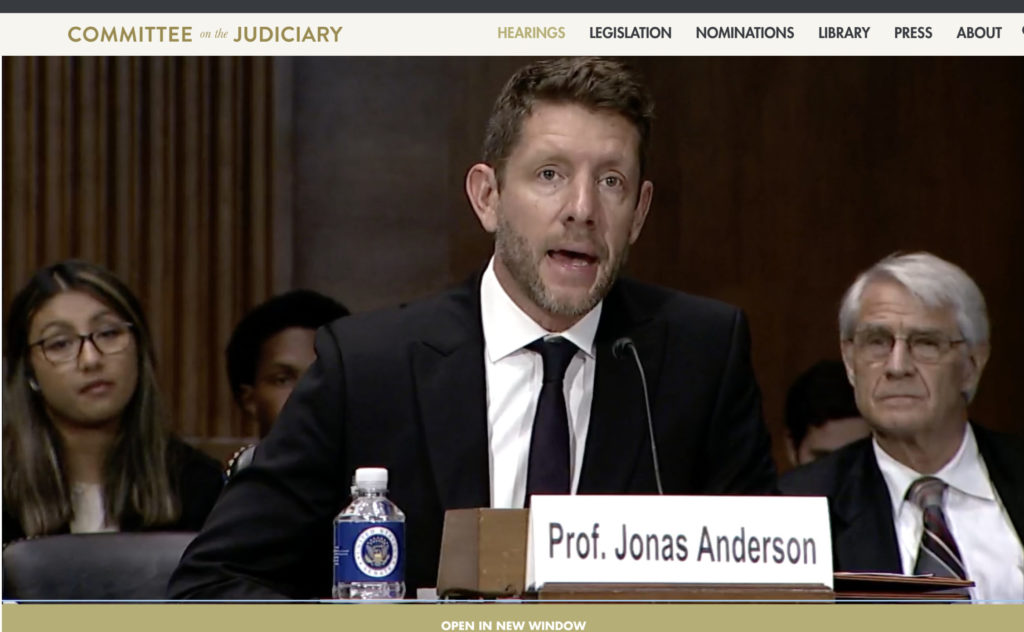“If you don’t like the compromise we’ve come up with, tell us – but don’t just tell us you hate it. Give us ideas.”- Senator Tillis
 Today, the Senate Committee on the Judiciary’s Subcommittee on Intellectual Property met to hear testimony from four witnesses about proposed changes to the Patent Trial and Appeal Board (PTAB) as outlined in the recently announced PTAB Reform Act. Subcommittee Chairman Senator Patrick Leahy (D-VT), Ranking Member Thom Tillis (R-NC) and Senator John Cornyn (R-TX) introduced the bill last week. Those testifying generally agreed the bill represents compromise and, at Tillis’ prompting, on a scale of green to red, scored it a green to yellow overall.
Today, the Senate Committee on the Judiciary’s Subcommittee on Intellectual Property met to hear testimony from four witnesses about proposed changes to the Patent Trial and Appeal Board (PTAB) as outlined in the recently announced PTAB Reform Act. Subcommittee Chairman Senator Patrick Leahy (D-VT), Ranking Member Thom Tillis (R-NC) and Senator John Cornyn (R-TX) introduced the bill last week. Those testifying generally agreed the bill represents compromise and, at Tillis’ prompting, on a scale of green to red, scored it a green to yellow overall.
The witnesses were David Cain, Director of Intellectual Property at GlobalFoundries; Tim Wilson, Head of Patents and Intellectual Property Litigation at SAS Institute, Inc.; Robert Giles, Senior Vice President and Chief Intellectual Property Counsel at Qualcomm Incorporated , on behalf of Innovation Alliance; and Jonas Anderson, Professor of Law at Washington College of Law, American University.
‘It Isn’t Perfect and it Isn’t Final’
 Leahy began by explaining that many believe “all meritorious patents should result in [PTAB] review” and that the PTAB Reform Act strikes a compromise by indicating that meritorious review should generally be granted, while serial petitions from the same or related parties will not be allowed.
Leahy began by explaining that many believe “all meritorious patents should result in [PTAB] review” and that the PTAB Reform Act strikes a compromise by indicating that meritorious review should generally be granted, while serial petitions from the same or related parties will not be allowed.
The hearing came on the same day that U.S. Patent and Trademark Office (USPTO) Director Kathi Vidal announced interim guidance on discretionary denial practice for the PTAB, in which she clarified that application of the so-called Fintiv factors governing discretionary denials will be limited to the facts of the Apple Inc. v. Fintiv, Inc. case from which it derives, excluding consideration of parallel International Trade Commission (ITC) investigations, for example. She also noted that “to benefit the patent system and the public good, the PTAB will not rely on the Fintiv factors to discretionarily deny institution in view of parallel district court litigation where a petition presents compelling evidence of unpatentability.”
Tillis’ introduction to the hearing included a disclaimer that “this bill isn’t perfect, and it isn’t final, and I’m pretty sure that when it’s final it won’t be perfect,” but said that he is confident it will be able to address most of the concerns that have been raised. “This is the beginning of a process,” Tillis said. “If you don’t like the compromise we’ve come up with, tell us – but don’t just tell us you hate it. Give us ideas.”
A Solid Yellow
 Along those lines, Tillis at one point asked each of the witnesses to rate the PTAB Reform Act on a scale of green for good to red for bad. Cain, head of IP at one of the world’s leading semiconductor manufacturers, said he feels the proposals are “much more green,” with the “worst case” provisions being yellow. In earlier remarks, Cain said he feels the PTAB has been a fair adjudicator of patent validity and that the company has been happy with PTAB results both as a patent owner and as a petitioner. “We have an extreme amount of innovation going on at our facilities and we count on the system to protect that innovation; we’ve seen very fair and very reasoned decisions coming out of the PTAB,” he said.
Along those lines, Tillis at one point asked each of the witnesses to rate the PTAB Reform Act on a scale of green for good to red for bad. Cain, head of IP at one of the world’s leading semiconductor manufacturers, said he feels the proposals are “much more green,” with the “worst case” provisions being yellow. In earlier remarks, Cain said he feels the PTAB has been a fair adjudicator of patent validity and that the company has been happy with PTAB results both as a patent owner and as a petitioner. “We have an extreme amount of innovation going on at our facilities and we count on the system to protect that innovation; we’ve seen very fair and very reasoned decisions coming out of the PTAB,” he said.
Wilson of SAS Institute said that SAS would prefer to remove the PTAB’s “discretion not to institute good petitions” completely, but that “there’s a fair compromise here amongst all of the interests.” The PTAB Reform Act currently says: “In deciding whether to institute an inter partes review proceeding, the Director shall not in any respect consider an ongoing civil action or a proceeding before the International Trade Commission,” thus steeply curbing the PTAB’s ability to discretionarily deny petitions compared to current guidance. While today’s memo took parallel ITC proceedings off the table, it left open the possibility of denying institution based on parallel district court proceedings. “We support this process and all of the compromises so far have been positive; yellow is where we are across the board,” Wilson added.
In his introductory remarks, Wilson said that “the America Invents Act [AIA] has largely done its job by leading to a large decrease in patent litigation,” noting that his company had almost 8,000 patent litigations in 2011, which has been brought down to 3,000 – 4,000 annual patent litigations lately. “I think that’s a great thing,” he said.
For Patent Owners, Coons’ Bill is STRONGER
 Giles, representing the Innovation Alliance, said that, while adoption of the Phillips standard for claim construction in the PTAB Reform Act “is a step in the right direction, overall we look to the STRONGER Patents Act as a little bit more fair and balanced.” However, he stopped short of rating it red. “I would say it’s yellow,” Giles said.
Giles, representing the Innovation Alliance, said that, while adoption of the Phillips standard for claim construction in the PTAB Reform Act “is a step in the right direction, overall we look to the STRONGER Patents Act as a little bit more fair and balanced.” However, he stopped short of rating it red. “I would say it’s yellow,” Giles said.
Senator Chris Coons, who introduced the STRONGER Patents Act, also took part in today’s questioning, and said he is concerned that the PTAB Reform Act’s elimination of the ability to consider co-pending litigation in deciding whether to institute an AIA proceeding “is a step in the wrong direction.” He added that “hard wiring parallel proceedings into the AIA increases costs by encouraging duplicative proceedings and in my view that doesn’t’ benefit the public or the patent system.”
Coons asked Giles what the benefits are to the public and patent system of evaluating concerns about redundant and duplicative proceedings in deciding whether or not to institute an AIA trial. Giles replied that removing that discretion will make parallel proceedings much more likely and “will astronomically increase costs for small businesses to assert their patent rights.” While the PTAB Reform Act contemplates covering costs of AIA trials for small businesses and independent inventors, Coons expressed skepticism about the viability of that and asked Cain what the costs would be. While he didn’t know precisely, Cain replied that he believed it is “very infrequent” that an individual inventor asserting their patent is brought into the IPR system, presumably making the costs of covering such instances relatively low.
Giles told Coons that the largest concern for patent owners that they would like to see addressed in the bill is changing the burden of proof at the PTAB from a preponderance of the evidence standard to clear and convincing. “If the PTAB is acting as an alternative, faster forum, the burden of proof should align as well,” Giles said. He later noted in response to a question from Senator Marsha Blackburn (R-TN) that in district court proceedings, about 30% of patent claims can be expected to be invalidated, while at the PTAB it’s at least twice that high, “if not more,” due to the differing standards.
‘Extreme Concentration’ of Patent Cases Erodes Public Trust
 Anderson, a professor whose specific focus has been on federal district courts that seek to attract patent cases to their courtrooms and who believes that the competition among courts for patent cases “is a threat to the judiciary’s legitimacy, not just in patent law but across other areas of law as well,” disagreed, but said the bill is mostly green and “good overall.”
Anderson, a professor whose specific focus has been on federal district courts that seek to attract patent cases to their courtrooms and who believes that the competition among courts for patent cases “is a threat to the judiciary’s legitimacy, not just in patent law but across other areas of law as well,” disagreed, but said the bill is mostly green and “good overall.”
He explained that the effect of the Fintiv ruling “threatens to erode public confidence in the judiciary” and said that, in 2021, roughly 25% of all patent cases were heard by a single federal district court judge (likely alluding to Judge Alan Albright of the Western District of Texas). “This extreme concentration of patent cases is troubling for the judiciary,” Anderson said. “Judges actively encouraging plaintiffs to file in their courtrooms undermines the public perception of fairness in judicial proceedings. The PTAB has been a great benefit for the U.S. system by providing a cost-effective means for challenging the validity of patents. But I also believe Fintiv has led to increased uncertainty.”
Anderson said that while Vidal’s guidance announced this morning limits the applicability of Fintiv, “the PTO ought to rescind the rule entirely” because “the current six-factor test provides no certainty of outcome and, worse, is influenced by plaintiffs who can strategically file their cases in an effort to avoid PTAB review in a court with a reputation for not issuing stays and setting very early trial dates.”
But Giles noted in his response to a question from Leahy many of the issues raised around Fintiv by the other witnesses have been worked out by the patent office in the last few years and that much of the data around trial dates had to do with COVID restrictions. “I don’t think it gives a very accurate description of when a trial date actually stays,” Giles said. “And the Director came out today and cleared up the guidance.”
Conservatives for Property Rights also came out against the PTAB Reform Act’s approach to this and other issues today, arguing that it “would turn an already Kafkaesque nightmare system for inventors and patent owners into a never-ending cycle of administrative validity challenges.”
If You Don’t Like it, Engage
Leahy and Tillis asked the witnesses to submit additional thoughts and responses in writing and that the record will remain open for seven days. But Tillis made it clear that “the dialogue will continue beyond seven days,” inviting everyone with ideas to the table. “The only thing I don’t tolerate are guerilla tactics to try and undermine what we’re trying to do here. But I would encourage anyone else who’s watching what we’re doing here to engage.”

![[IPWatchdog Logo]](https://ipwatchdog.com/wp-content/themes/IPWatchdog%20-%202023/assets/images/temp/logo-small@2x.png)

![[Advertisement]](https://ipwatchdog.com/wp-content/uploads/2024/04/Artificial-Intelligence-2024-REPLAY-sidebar-700x500-corrected.jpg)
![[Advertisement]](https://ipwatchdog.com/wp-content/uploads/2024/04/UnitedLex-May-2-2024-sidebar-700x500-1.jpg)
![[Advertisement]](https://ipwatchdog.com/wp-content/uploads/2024/04/Patent-Litigation-Masters-2024-sidebar-700x500-1.jpg)

![[Advertisement]](https://ipwatchdog.com/wp-content/uploads/2021/12/WEBINAR-336-x-280-px.png)
![[Advertisement]](https://ipwatchdog.com/wp-content/uploads/2021/12/2021-Patent-Practice-on-Demand-recorded-Feb-2021-336-x-280.jpg)
![[Advertisement]](https://ipwatchdog.com/wp-content/uploads/2021/12/Ad-4-The-Invent-Patent-System™.png)






Join the Discussion
4 comments so far.
Greg DeLassus
June 23, 2022 11:51 amGiles… noted… that in district court proceedings, about 30% of patent claims can be expected to be invalidated, while at the PTAB it’s at least twice that high…
Does anyone know the source for this statistic? I would be interested to see that study.
PA Crier
June 23, 2022 09:27 amNothing in this bill addresses the root cause of why PTAB petitions are filed. Noting in this bill will reduce the frequency of patents or patent claims from being canceled or the frequency of filings. It nibbles around the edge of the central problem.
Patents are overturned in PTAB proceedings because no one, neither the applicant or the PTO, made an attempt to find facts necessary to determine average skill in the art before the patent issued. How can you award validity when you don’t know average skill in the art first?
The proposal calls for paying for the defense of micro-entity defendants. Here’s an idea. How about paying every micro-entity applicant $2000.00 to have a private sector patentability investigation, e.g. average skill in the art, done before sending the application to the examiner. Just joking of course since there is no infrastructure to actually meet the demand of a large number of micro-entity small applicants but just saying.
Until the US fixes the problem of no fact finding before issue, the absurdity of the PTO invalidating patents they themselves issue will not go away.
Pro Say
June 22, 2022 11:47 pm. . . and with no actual independent inventors who’ve had their duly-issued patents invalidated being invited to testify, it’s no wonder that the kangaroos ran wild . . . at this kangaroo hearing.
Thank goodness for Senators including Chris Coons; who understand only too well the need to reign in the Death Squad PTAB.
” . . . in district court proceedings, about 30% of patent claims can be expected to be invalidated, while at the PTAB it’s at least twice that high, “if not more,” due to the differing standards.”
With the hamstringing of American innovation being the end result.
mike
June 22, 2022 07:23 pmThe only thing I don’t tolerate are guerilla tactics to try and undermine what we’re trying to do here.
— Senator Tillis
OK, well how’s this for guerilla tactics—the Senators of the PTAB Reform Act are trying to rewrite the legislative history so they can get their desired result of undoing Fintiv and Director Vidal’s recently published guidance, and I’m calling you out right here for the public to see.
The Senators provided a myth vs fact document to “sell” the PTAB Reform Act, and in that document, they say that is a fact that “the intent of the PTAB” is “to offer a cost-effective replacement to litigation.” That is a lie.
The phrase “replacement to litigation” (or even such an idea) is nowhere to be found in the Congressional Record of the Leahy-Smith America Invents Act of 2011. It’s not in the House Report, not in the June 22 or June 23 House debates, and not in the September Senate debate.
Instead, the phrase repeatedly used throughout the legislative history is that the PTAB was to offer a “less costly, more efficient alternative to litigation“. This “alternative to litigation” intent was mentioned 16 times in the AIA legislative history.
Words matter. Replacing something and being an alternative to that something are two entirely different things. Suggesting that the AIA was intended to offer a replacement to litigation calls into question efficiency and costs, and more importantly, for whom—for infringers or for patent owners. For example, if an inventor can obtain a cheaper and more efficient result in district court, the Director should have the discretion to consider such a civil action in deciding whether to institute an IPR proceeding. Invoking the PTAB in this instance would only delay her result, creating duplicative proceedings and increasing her costs, which is not more efficient and not less costly—being the exact opposite of what Congress intended. This is not fair for the inventor. Not only that, the PTAB could conflict with the court’s ruling, which does not provide predictability for the inventor or even for society.
This seems eerily similar to the “backdoor” attempt that Sherry Knowles called out in a Senator letter provided to Director Vidal just last week.
Can the Senators please inform the public why they believe that rewriting congressional intent is justified? We’d really like to know why you are engaging in that guerilla tactic, flying in the face of the People’s elected Congress.